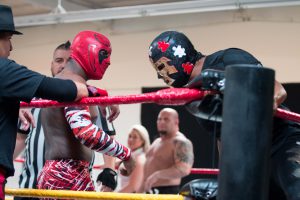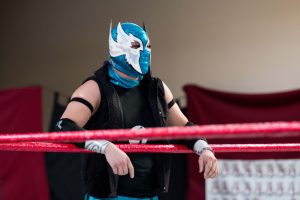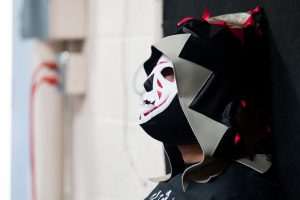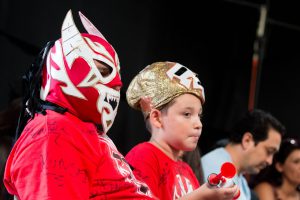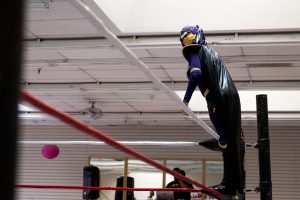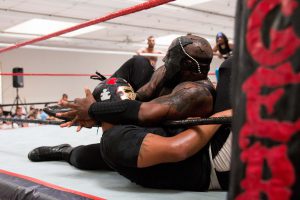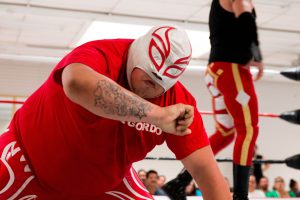- Slug: Lucha libre
- Video available
- 13 photos for slideshow available (thumbnails and captions below)
By RIAN BOSSE
Cronkite News
On Sundays, Sergio De La Rosa recreates an important part of his past that he has carried since he was born in El Paso and raised in Juarez. De La Rosa runs P.o.r. Promotions, which showcases lucha libre, the colorful and highly acrobatic style of Mexican wrestling with deep roots across the border.
Each week, De La Rosa draws fans to cheer on larger-than-life characters as they flip and fly in theatrical battles of good versus evil. Like many of the fans who frequent the show, a passion for lucha libre is shared among families, passed down through generations from parents and grandparents who grew up watching legendary masked luchadores like El Santo and Blue Demon. De La Rosa’s family helps out with each show, announcing the matches as wrestlers enter the arena, running the concession stand and even refereeing in the ring.
“We’ve been related to wrestling since I was five, six years old in Mexico. I remember my older brothers used to take me to the lucha libre shows,” he said. “I loved it.”
While it’s still very much a niche form of entertainment, fans and promoters say lucha libre is growing here in the Valley. De La Rosa said that a dozen or so fans would come to his shows when he first started four years ago. Now, he can draw up to 200 people at a time.
That growing popularity has helped multiple promotions like P.o.r. put on regular shows starring local talent, luchadores from Mexico and others from South America and around the world, sometimes performing in front of hundreds of people. And with the athletic spectacle so closely associated with Mexican culture, local bars and food festivals have even used shows to attract and entertain customers.
This growing popularity has reached national levels, where the lucha libre style influences American professional wrestling and has helped further Mexican and Latino culture into American entertainment. Lucha libre has evolved in the borderlands as well, where styles and cultures from around the world come together.
“It’s tradition, but more than that. It’s a way of life,” De La Rosa said. “You get addicted to it.”
Lucha style
Lucha libre is known for its fast pace and highly athletic performances. While American professional wrestling has often relied on large heavyweights, lucha libre incorporates more dives, submission grapples and tosses inside and outside of the ring.
Lucha libre is also a participatory form of theatre, perhaps even more so than its American counterpart. As luchadores enter the arena individually or as a group, crowds immediately call out their support for técnicos, the protagonists of the story in the ring, andshow their disdain for rudos, the antagonists.
Crowds at shows like P.o.r. usehorns, honkers, whistles and matracas, Mexican noisemakers. When their heroes fall behind in a match, fans chant in unison to help the luchadore recover and build momentum. When a wrestler pins an opponent’s shoulders to the mat for a count of three, scoring the needed number of pinfalls for a match, the audience cheers for the técnico’s victory or boos the rudos, who often cheat to gain advantage.
But lucha libre is probably best known for its masks, many intricately designed with mystical and mythological elements. It’s a deeply rooted tradition for these masks to form a luchadore’s identity, and traditional luchadores even wear them outside the ring.
“What I love the most is the mask. A lot of colors,” De La Rosa said. “It’s passion, and lucha libre gives us a lot.”
WWE has even launched an inaugural tournament, the Cruiserweight Classic, which showcases a mixture of wrestlers with international styles, including the Mexican luchadore Gran Metalik and other wrestlers from Latin America. The signing of Andrade “Cien” Almas, who starred in Mexico as La Sombra, to WWE’s developmental promotion NXT is another indication of the influence.
The shift reflects the changing demographics in the United States. According to the Pew Research Center, there were 55.3 million Hispanics in the United States in 2014, which is just over 17 percent of the general population. That’s up from 14.8 million in 1980, which made up just 6.5 percent of the general population. Of the Hispanics in the U.S. in 2014, 64 percent were of Mexican origin.
WWE, which reported revenue of $659 million last year, had just over 20 percent of its audience considered avid fans in the Hispanic demographic in 2013, according to Scarborough Research findings cited by Sports Business Daily.
“This is only the beginning. It’s about to be a lucha libre takeover. It’s about something even bigger,” said Luiz “Voz” Sanchez, who runs Lucha Libre Voz. “The acceptance of WWE to lucha was their opening the door to an audience that was asking for it.”
These demographic changes have also opened up opportunity for other national promotions, including Lucha Underground, which is entering its third season on El Rey. Lucha Underground is original programming that features elements of lucha libre infused with telenovelas popular in Mexico.
“The fact is, there’s still not enough out there. There’s still a need and a cry from the community to be represented in the media,” said Daniel Tibbets, the president and general manager of El Rey. “With all the product in media now available to people in this country, there’s still not enough representation of who America is today and respecting the cultures that they come from.”
Lucha evolves in the borderlands
That evolution within lucha libre is evident at local promotions along the U.S. and Mexico border as well, where it often mirrors the mix of Mexican and American culture in the region.
Sanchez, who has run Lucha Libre Voz for 17 months, also spent part of his childhood in Mexico idolizing luchadores. But he said his promotion reflects a lot of what is in his cultural identity as a Mexican-American who grew up “divided between two countries.”
“Our promotion is a little different because it’s not American wrestling and it’s not lucha libre Mexicana, like Mexican lucha libre,” he said during a show on a Friday night in Glendale. “We’re like a hybrid, as far as the style…So we’re like a brand new fusion. We’re like the melting pot of lucha.”
When Sanchez climbs into the ring to announce to the crowd, he moves between Spanish and English.
“We want to introduce it to everybody. We don’t want anyone to feel uncomfortable because they don’t speak the language,” Sanchez said.
And for both Sanchez and De La Rosa, that mixture in style and presentation is working to bring in fans. During a Cinco de Mayo show outside of Cobra Arcade Bar in downtown Phoenix, Sanchez said he had hundreds of interested spectators stop to watch matches.
“There was no wrestling [before], that’s why you see more and more people come out,” said Mike Lugo, a fan who attends shows by both promotions.
“It is transcending that cultural heritage,” Sanchez said. “It’s amazing because you do see that influence, especially around the border. People are not closing themselves down to what’s different.”
^__=
